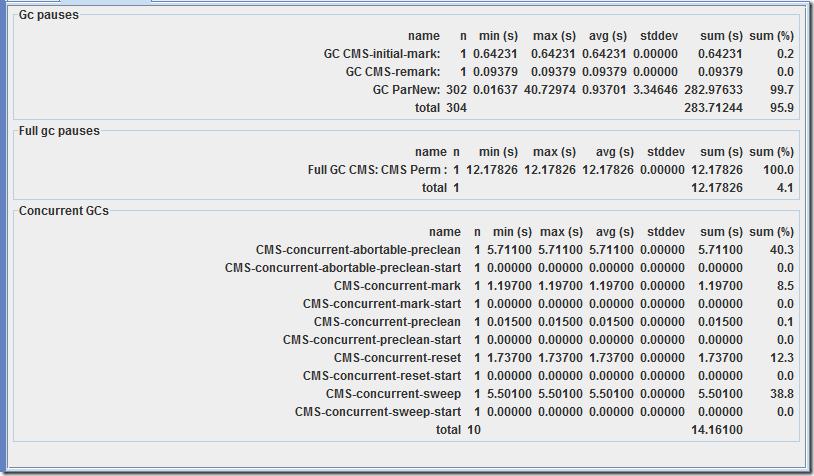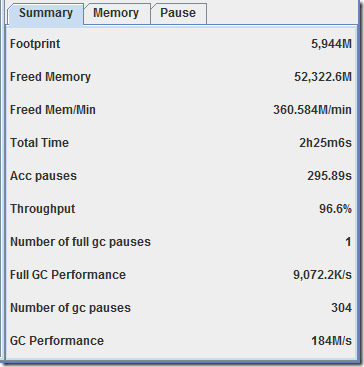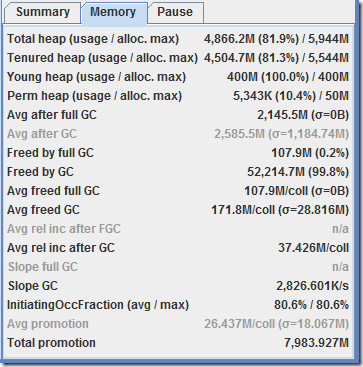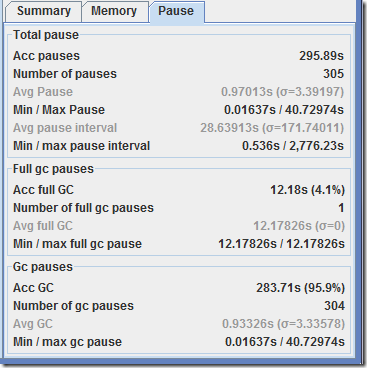前言
每一种该语言在某些极限情况下的表现一般都不太一样,那么我常用的Java语言,在达到100万个并发连接情况下,会怎么样呢,有些好奇,更有些期盼。
这次使用经常使用的顺手的netty NIO框架(netty-3.6.5.Final),封装的很好,接口很全面,就像它现在的域名 netty.io,专注于网络IO。
整个过程没有什么技术含量,浅显分析过就更显得有些枯燥无聊,准备好,硬着头皮吧。
测试服务器配置
运行在VMWare Workstation 9中,64位Centos 6.2系统,分配14.9G内存左右,4核。
已安装有Java7版本:
java version "1.7.0_21"
Java(TM) SE Runtime Environment (build 1.7.0_21-b11)
Java HotSpot(TM) 64-Bit Server VM (build 23.21-b01, mixed mode)
在/etc/sysctl.conf中添加如下配置:
fs.file-max = 1048576
net.ipv4.ip_local_port_range = 1024 65535
net.ipv4.tcp_mem = 786432 2097152 3145728
net.ipv4.tcp_rmem = 4096 4096 16777216
net.ipv4.tcp_wmem = 4096 4096 16777216
net.ipv4.tcp_tw_reuse = 1
net.ipv4.tcp_tw_recycle = 1
在/etc/security/limits.conf中添加如下配置:
* soft nofile 1048576
* hard nofile 1048576
测试端
测试端无论是配置还是程序和以前一样,翻看前几篇博客就可以看到client5.c的源码,以及相关的配置信息等。
服务器程序
这次也是很简单呐,没有业务功能,客户端HTTP请求,服务端输出chunked编码内容。
入口HttpChunkedServer.java:
package com.test.server;
import static org.jboss.netty.channel.Channels.pipeline;
import java.net.InetSocketAddress;
import java.util.concurrent.Executors;
import org.jboss.netty.bootstrap.ServerBootstrap;
import org.jboss.netty.channel.ChannelPipeline;
import org.jboss.netty.channel.ChannelPipelineFactory;
import org.jboss.netty.channel.socket.nio.NioServerSocketChannelFactory;
import org.jboss.netty.handler.codec.http.HttpChunkAggregator;
import org.jboss.netty.handler.codec.http.HttpRequestDecoder;
import org.jboss.netty.handler.codec.http.HttpResponseEncoder;
import org.jboss.netty.handler.stream.ChunkedWriteHandler;
public class HttpChunkedServer {
private final int port;
public HttpChunkedServer(intport) {
this.port = port;
}
public void run() {
// Configure the server.
ServerBootstrap bootstrap = new ServerBootstrap(
new NioServerSocketChannelFactory(
Executors.newCachedThreadPool(),
Executors.newCachedThreadPool()));
// Set up the event pipeline factory.
bootstrap.setPipelineFactory(newChannelPipelineFactory() {
public ChannelPipeline getPipeline ()throws Exception {
ChannelPipeline pipeline = pipeline();
pipeline.addLast("decoder", new HttpRequestDecoder());
pipeline.addLast("aggregator", new HttpChunkAggregator(65536));
pipeline.addLast("encoder", new HttpResponseEncoder());
pipeline.addLast("chunkedWriter", new ChunkedWriteHandler());
pipeline.addLast("handler", new HttpChunkedServerHandler());
return pipeline;
}
});
bootstrap.setOption("child.reuseAddress", true);
bootstrap.setOption("child.tcpNoDelay", true);
bootstrap.setOption("child.keepAlive", true);
// Bind and start to accept incoming connections.
bootstrap.bind(newInetSocketAddress(port));
}
public static void main(String[] args) {
int port;
if (args.length > 0) {
port = Integer.parseInt(args[0]);
} else {
port = 8080;
}
System.out.format("server start with port %d
", port);
new HttpChunkedServer(port).run();
}
}
唯一的自定义处理器HttpChunkedServerHandler.java:
package com.test.server;
import static org.jboss.netty.handler.codec.http.HttpHeaders.Names.CONTENT_TYPE;
import static org.jboss.netty.handler.codec.http.HttpMethod.GET;
import static org.jboss.netty.handler.codec.http.HttpResponseStatus.BAD_REQUEST;
import static org.jboss.netty.handler.codec.http.HttpResponseStatus.METHOD_NOT_ALLOWED;
import static org.jboss.netty.handler.codec.http.HttpResponseStatus.OK;
import static org.jboss.netty.handler.codec.http.HttpVersion.HTTP_1_1;
import java.util.concurrent.atomic.AtomicInteger;
import org.jboss.netty.buffer.ChannelBuffer;
import org.jboss.netty.buffer.ChannelBuffers;
import org.jboss.netty.channel.Channel;
import org.jboss.netty.channel.ChannelFutureListener;
import org.jboss.netty.channel.ChannelHandlerContext;
import org.jboss.netty.channel.ChannelStateEvent;
import org.jboss.netty.channel.ExceptionEvent;
import org.jboss.netty.channel.MessageEvent;
import org.jboss.netty.channel.SimpleChannelUpstreamHandler;
import org.jboss.netty.handler.codec.frame.TooLongFrameException;
import org.jboss.netty.handler.codec.http.DefaultHttpChunk;
import org.jboss.netty.handler.codec.http.DefaultHttpResponse;
import org.jboss.netty.handler.codec.http.HttpChunk;
import org.jboss.netty.handler.codec.http.HttpHeaders;
import org.jboss.netty.handler.codec.http.HttpRequest;
import org.jboss.netty.handler.codec.http.HttpResponse;
import org.jboss.netty.handler.codec.http.HttpResponseStatus;
import org.jboss.netty.util.CharsetUtil;
public class HttpChunkedServerHandlerextends SimpleChannelUpstreamHandler {
private static final AtomicInteger count = new AtomicInteger(0);
private void increment() {
System.out.format("online user %d
", count.incrementAndGet());
}
private void decrement() {
if (count.get() <= 0) {
System.out.format("~online user %d
", 0);
} else {
System.out.format("~online user %d
", count.decrementAndGet());
}
}
@Override
public void messageReceived(ChannelHandlerContextctx, MessageEvent e)
throws Exception {
HttpRequest request = (HttpRequest) e.getMessage();
if (request.getMethod() != GET) {
sendError(ctx, METHOD_NOT_ALLOWED);
return;
}
sendPrepare(ctx);
increment();
}
@Override
public void channelDisconnected(ChannelHandlerContextctx,
ChannelStateEvent e) throws Exception {
decrement();
super.channelDisconnected(ctx, e);
}
@Override
public void exceptionCaught(ChannelHandlerContextctx, ExceptionEvent e)
throws Exception {
Throwable cause = e.getCause();
if (cause instanceof TooLongFrameException) {
sendError(ctx, BAD_REQUEST);
return;
}
}
private static void sendError(ChannelHandlerContext ctx,
HttpResponseStatus status) {
HttpResponse response = new DefaultHttpResponse(HTTP_1_1, status);
response.setHeader(CONTENT_TYPE, "text/plain; charset=UTF-8");
response.setContent(ChannelBuffers.copiedBuffer(
"Failure:" + status.toString() + "
", CharsetUtil.UTF_8));
// Close the connection as soon as the error message is sent.
ctx.getChannel().write(response)
.addListener(ChannelFutureListener.CLOSE);
}
private void sendPrepare(ChannelHandlerContextctx) {
HttpResponse response = new DefaultHttpResponse(HTTP_1_1, OK);
response.setChunked(true);
response.setHeader(HttpHeaders.Names.CONTENT_TYPE,
"text/html; charset=UTF-8");
response.addHeader(HttpHeaders.Names.CONNECTION,
HttpHeaders.Values.KEEP_ALIVE);
response.setHeader(HttpHeaders.Names.TRANSFER_ENCODING,
HttpHeaders.Values.CHUNKED);
Channel chan = ctx.getChannel();
chan.write(response);
// 缓冲必须凑够256字节,浏览器端才能够正常接收 ...
StringBuilder builder = new StringBuilder();
builder.append("");
int leftChars = 256 - builder.length();
for (int i = 0; i < leftChars; i++) {
builder.append("");
}
writeStringChunk(chan, builder.toString());
}
private void writeStringChunk(Channelchannel, String data) {
ChannelBuffer chunkContent = ChannelBuffers.dynamicBuffer(channel
.getConfig().getBufferFactory());
chunkContent.writeBytes(data.getBytes());
HttpChunk chunk = new DefaultHttpChunk(chunkContent);
channel.write(chunk);
}
}
启动脚本start.sh
set CLASSPATH=.
nohup java -server -Xmx6G -Xms6G -Xmn600M -XX:PermSize=50M -XX:MaxPermSize=50M -Xss256K -XX:+DisableExplicitGC -XX:SurvivorRatio=1 -XX:+UseConcMarkSweepGC -XX:+UseParNewGC -XX:+CMSParallelRemarkEnabled -XX:+UseCMSCompactAtFullCollection -XX:CMSFullGCsBeforeCompaction=0 -XX:+CMSClassUnloadingEnabled -XX:LargePageSizeInBytes=128M -XX:+UseFastAccessorMethods -XX:+UseCMSInitiatingOccupancyOnly -XX:CMSInitiatingOccupancyFraction=80 -XX:SoftRefLRUPolicyMSPerMB=0 -XX:+PrintClassHistogram -XX:+PrintGCDetails -XX:+PrintGCTimeStamps -XX:+PrintHeapAtGC -Xloggc:gc.log -Djava.ext.dirs=lib com.test.server.HttpChunkedServer 8000>server.out 2>&1 &
达到100万并发连接时的一些信息
每次服务器端达到一百万个并发持久连接之后,然后关掉测试端程序,断开所有的连接,等到服务器端日志输出在线用户为0时,再次重复以上步骤。在这反反复复的情况下,观察内存等信息的一些情况。以某次断开所有测试端为例后,当前系统占用为(设置为list_free_1):
total used free shared buffers cached
Mem: 15189 7736 7453 0 18 120
-/+ buffers/cache: 7597 7592
Swap: 4095 948 3147
通过top观察,其进程相关信息
PID USER PR NI VIRT RES SHR S %CPU %MEM TIME+ COMMAND
4925 root 20 0 8206m 4.3g 2776 S 0.3 28.8 50:18.66 java
在启动脚本start.sh中,我们设置堆内存为6G。
ps aux|grep java命令获得信息:
root 4925 38.0 28.8 8403444 4484764 ? Sl 15:26 50:18 java -server...HttpChunkedServer 8000
RSS占用内存为4484764K/1024K=4379M
然后再次启动测试端,在服务器接收到online user 1023749时,ps aux|grep java内容为:
root 4925 43.6 28.4 8403444 4422824 ? Sl 15:26 62:53 java -server...
查看当前网络信息统计
ss -s
Total: 1024050 (kernel 1024084)
TCP: 1023769 (estab 1023754, closed 2, orphaned 0, synrecv 0, timewait 0/0), ports 12
Transport Total IP IPv6
* 1024084 - -
RAW 0 0 0
UDP 7 6 1
TCP 1023767 12 1023755
INET 1023774 18 1023756
FRAG 0 0 0
通过top查看一下
top -p 4925
top - 17:51:30 up 3:02, 4 users, load average: 1.03, 1.80, 1.19
Tasks: 1 total, 0 running, 1 sleeping, 0 stopped, 0 zombie
Cpu0 : 0.9%us, 2.6%sy, 0.0%ni, 52.9%id, 1.0%wa, 13.6%hi, 29.0%si, 0.0%st
Cpu1 : 1.4%us, 4.5%sy, 0.0%ni, 80.1%id, 1.9%wa, 0.0%hi, 12.0%si, 0.0%st
Cpu2 : 1.5%us, 4.4%sy, 0.0%ni, 80.5%id, 4.3%wa, 0.0%hi, 9.3%si, 0.0%st
Cpu3 : 1.9%us, 4.4%sy, 0.0%ni, 84.4%id, 3.2%wa, 0.0%hi, 6.2%si, 0.0%st
Mem: 15554336k total, 15268728k used, 285608k free, 3904k buffers
Swap: 4194296k total, 1082592k used, 3111704k free, 37968k cached
PID USER PR NI VIRT RES SHR S %CPU %MEM TIME+ COMMAND
4925 root 20 0 8206m 4.2g 2220 S 3.3 28.4 62:53.66 java
四核都被占用了,每一个核心不太平均。这是在虚拟机中得到结果,可能真实服务器会更好一些。 因为不是CPU密集型应用,CPU不是问题,无须多加关注。
系统内存状况
free -m
total used free shared buffers cached
Mem: 15189 14926 263 0 5 56
-/+ buffers/cache: 14864 324
Swap: 4095 1057 3038
物理内存已经无法满足要求了,占用了1057M虚拟内存。
查看一下堆内存情况
jmap -heap 4925
Attaching to process ID 4925, please wait...
Debugger attached successfully.
Server compiler detected.
JVM version is 23.21-b01
using parallel threads in the new generation.
using thread-local object allocation.
Concurrent Mark-Sweep GC
Heap Configuration:
MinHeapFreeRatio = 40
MaxHeapFreeRatio = 70
MaxHeapSize = 6442450944 (6144.0MB)
NewSize = 629145600 (600.0MB)
MaxNewSize = 629145600 (600.0MB)
OldSize = 5439488 (5.1875MB)
NewRatio = 2
SurvivorRatio = 1
PermSize = 52428800 (50.0MB)
MaxPermSize = 52428800 (50.0MB)
G1HeapRegionSize = 0 (0.0MB)
Heap Usage:
New Generation (Eden + 1 Survivor Space):
capacity = 419430400 (400.0MB)
used = 308798864 (294.49354553222656MB)
free = 110631536 (105.50645446777344MB)
73.62338638305664% used
Eden Space:
capacity = 209715200 (200.0MB)
used = 103375232 (98.5863037109375MB)
free = 106339968 (101.4136962890625MB)
49.29315185546875% used
From Space:
capacity = 209715200 (200.0MB)
used = 205423632 (195.90724182128906MB)
free = 4291568 (4.0927581787109375MB)
97.95362091064453% used
To Space:
capacity = 209715200 (200.0MB)
used = 0 (0.0MB)
free = 209715200 (200.0MB)
0.0% used
concurrent mark-sweep generation:
capacity = 5813305344 (5544.0MB)
used = 4213515472 (4018.321487426758MB)
free = 1599789872 (1525.6785125732422MB)
72.48054631000646% used
Perm Generation:
capacity = 52428800 (50.0MB)
used = 5505696 (5.250640869140625MB)
free = 46923104 (44.749359130859375MB)
10.50128173828125% used
1439 interned Strings occupying 110936 bytes.
老生代占用内存为72%,较为合理,毕竟系统已经处理100万个连接。
再次断开所有测试端,看看系统内存(free -m)
total used free shared buffers cached
Mem: 15189 7723 7466 0 13 120
-/+ buffers/cache: 7589 7599
Swap: 4095 950 3145
记为list_free_2。
list_free_1和list_free_2两次都释放后的内存比较结果,系统可用物理已经内存已经降到7589M,先前可是7597M物理内存。
总之,我们的JAVA测试程序在内存占用方面已经,最低需要7589 + 950 = 8.6G内存为最低需求内存吧。
GC日志
我们在启动脚本处设置的一大串参数,到底是否达到目标,还得从gc日志处获得具体效果,推荐使用GCViewer。
总之:
- 只进行了一次Full GC,代价太高,停顿了12秒。
- PartNew成为了停顿大户,导致整个系统停顿了41秒之久,不可接受。
- 当前JVM调优喜忧参半,还得继续努力等
小结
Java与与Erlang、C相比,比较麻烦的事情,需要在程序一开始就得准备好它的堆栈到底需要多大空间,换个说法就是JVM启动参数设置堆内存大小,设置合适的垃圾回收机制,若以后程序需要更多内存,需停止程序,编辑启动参数,然后再次启动。总之一句话,就是麻烦。单单JVM的调优,就得持续不断的根据检测、信息、日志等进行适当微调。
- JVM需要提前指定堆大小,相比Erlang/C,这可能是个麻烦
- GC(垃圾回收),相对比麻烦,需要持续不断的根据日志、JVM堆栈信息、运行时情况进行JVM参数微调
- 设置一个最大连接目标,多次测试达到顶峰,然后释放所有连接,反复观察内存占用,获得一个较为合适的系统运行内存值
- Eclipse Memory Analyzer结合jmap导出堆栈DUMP文件,分析内存泄漏,还是很方便的
- 想修改运行时内容,或者称之为热加载,默认不可能
- 真实机器上会有更好的反映
吐槽一下:
JAVA OSGI,相对比Erlang来说,需要人转换思路,不是那么原生的东西,总是有些别扭,社区或商业公司对此的修修补补,不过是实现一些面向对象所不具备的热加载的企业特性。
测试源代码,下载just_test。
无编程不创客,无案例不学习。疯狂创客圈,一大波高手正在交流、学习中!
疯狂创客圈 Netty 死磕系列 10多篇深度文章: 【博客园 总入口】 QQ群:104131248



